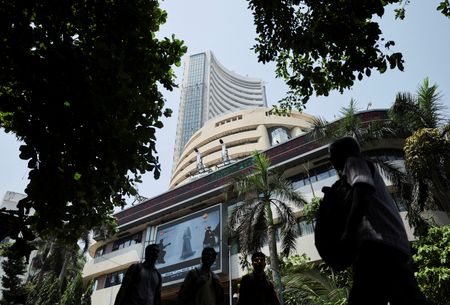By Manoj Kumar
NEW DELHI (Reuters) -India’s merchandise trade deficit widened to a record high of $41.68 billion in October, due to a rise in gold imports and a fall in U.S.-bound exports during the second month of steep U.S. tariffs on Indian goods, government data showed on Monday.
The trade deficit had widened to a 13-month high of $32.15 billion in September. In August 2024, the deficit stood at $35.62 billion, according to data from the Reserve Bank of India.
Economists had expected the October trade deficit to be $28.8 billion, according to a Reuters poll, compared to $32.15 billion in the previous month.
U.S. President Donald Trump’s administration imposed steep tariffs of up to 50% on Indian shipments at the end of August. October is the second full month when the tariffs remained in place, even as New Delhi and Washington continue the negotiations.
Exports to the U.S. fell nearly 9% year-on-year last month to $6.31 billion from $6.91 billion a year ago, and increased from $5.47 billion in September, as tariffs hit shipments of goods such as textiles, shrimp, and gems and jewellery, data released by the Commerce Ministry showed.
Overall merchandise exports fell to $34.38 billion last month from $36.38 billion in September, while imports climbed to $76.06 billion from $68.53 billion.
“There are discussions going on, and we hope again, part of the agreement which needs to agree on the reciprocal (tariffs)…..should happen. I don’t have a timeline in my mind, but it can happen,” said Trade Secretary Rajesh Agrawal.
Imports from the U.S. rose to $4.47 billion in October from $3.98 billion in the previous month.
Gold imports stood at $14.7 billion compared with $9.6 billion in September.
Crude oil imports rose to $14.8 billion in October from $14 billion in the previous month.
The government estimated October services exports at $38.52 billion and imports at $18.64 billion, suggesting a total services trade surplus at $19.88 billion, according to Reuters calculation.
India’s central bank publishes detailed monthly services trade data with a one-month lag, following government estimates.
RELIEF MEASURES
India has seen among the sharpest drop in container volume of shipments to the U.S. among other major trading partners.
U.S. container imports from the top 10 countries it buys goods from fell 9.4% year-on-year in October, led by a 16.3% drop from China and an 18.5% fall from India, according to Descartes, a supply chain technology provider. Shipments from Japan, Germany, South Korea, Vietnam, Indonesia rose following recent lower tariff agreements.
Last week, the Indian government and the Reserve Bank of India announced support measures for exporters, including incentives for export promotion and relief on loan repayments.
S.C. Ralhan, President of the Federation of Indian Export Organisations (FIEO), said these measures “offer much-needed relief, allowing exporters more time to ship goods against advance payments and eases liquidity through support on term loans and packing credit.”
He added that the move aligns with other major economies, “ensuring a level playing field for Indian exporters.”
Trump had doubled tariffs on Indian goods to 50% over Indian purchases of Russian oil. However, in his latest comments Trump said the United States and India are close to reaching a deal.
Meanwhile, the U.S. removed tariffs on dozens of agricultural items, offering some relief to Indian farmers.
(Reporting by Manoj Kumar in New Delhi; Writing by Shubham Batra; Editing by Mrigank Dhaniwala, Eileen Soreng, William Maclean)









